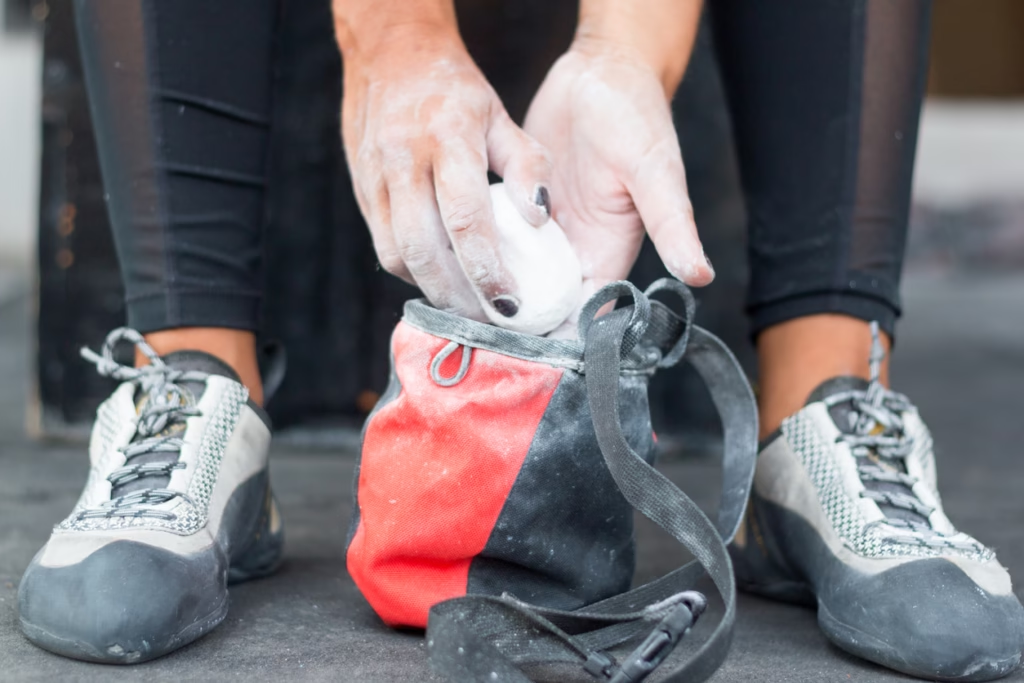Whether you’re a beginner or an advanced climber, a well-crafted hangboard is an indispensable tool for building finger strength. This guide ensures your DIY hangboard has proper hold depth and volume for effective and safe training. Check out our hangboard training plan tailored for both beginner and advanced climbers.
This is something that I have taken on as a project when I took off to the countryside last summer. Things can get a little too quiet and while resting is important, it can be boring. This is a great way to keep your fingers strong and to be creative at the same time.

Materials and Tools
Materials
- Thick Wood Slabs: Use hardwood like oak, maple, or birch, at least 2-3 inches thick to carve deep holds and edges. Plywood is suitable only as a backing board or for portability.
- Wood Blocks or Offcuts: For creating additional volumes or thicker jugs if your base wood isn’t thick enough.
- Wood Screws and Glue: For attaching additional blocks securely and reinforcing the structure.
- Cord or Webbing: For a portable design.
- Mounting Brackets or Backing Board: If wall-mounted, ensure you have a sturdy backing board to distribute weight evenly.
- Grip Tape (optional): For added texture on smooth wood.
Tools
- Jigsaw: To shape the hangboard and cut out holds.
- Drill and Drill Bits: For creating deep pockets and holes for mounting.
- Router or Dremel Tool: Essential for carving smooth, ergonomic holds with depth and volume.
- Rasp or File: To shape and refine edges.
- Clamps: For securing wood while carving and gluing.
- Sandpaper (60, 120, and 220 grit): To smooth out holds and edges.
- Measuring Tape and Pencil: For precise measurements and layouts.

Step 1: Plan Your Design
Key Features for Functionality
- Jugs: 2–3-inch-deep rounded holds for warm-ups and pull-ups.
- Edges: 0.5–1-inch-deep edges for finger strength training.
- Pockets: Two- or three-finger holds, 1–1.5 inches deep.
- Slopers: Rounded surfaces with gentle angles for grip strength.
- Custom Volumes: If your wood isn’t thick enough for deep holds, attach additional wood blocks for more depth.
Dimensions
- Width (20–24 inches): Provides sufficient space for a variety of holds, ensuring climbers of different shoulder widths can use the board comfortably.
- Height (12–16 inches): Allows enough room for multiple rows of holds while keeping the hangboard compact and portable.
- Depth (1–1.5 inches): The board itself should be thick enough to support screws and bolts for attaching holds without compromising structural integrity.
Sketch the layout on your wood, leaving space between each hold for safe gripping and to prevent overlapping stresses on the board.
Step 2: Cut and Shape the Wood
Baseboard
- Use a jigsaw to cut the wood into your desired rectangular or curved shape.
- If your wood is thin, glue and screw an additional slab or blocks to increase thickness for carving holds.
Carving the Holds
- Jugs: Use a router or Dremel tool to carve 2–3-inch rounded depressions into the top section of the board. Sand smooth for comfort.
- Edges: Carve straight, shallow indentations (0.5–1 inch deep) along the midsection. Use a file to soften the corners.
- Pockets: Drill circular holes (1–1.5 inches deep) for two- or three-finger pockets. Smooth the edges with a rasp.
- Slopers: Round the bottom edges with a rasp or router, creating a smooth incline.
- Sand the entire board using progressively finer grit sandpaper to eliminate splinters and create a comfortable, ergonomic surface.
Step 3: Reinforce the Hangboard
- Glue and Screw Additional Blocks: For deeper holds or slopers, attach extra wood blocks securely using wood glue and screws.
- Backboard for Wall Mounting: If you plan to mount it, attach your hangboard to a plywood backing to distribute weight evenly.

Step 4: Mounting Your Hangboard
Wall-Mounted Hangboard
- Drill mounting holes in the hangboard and backing board.
- Use heavy-duty screws or anchors to secure the board to studs in the wall.
- Ensure the board is level and can handle your full body weight.
Portable Hangboard
- Drill two holes at the top corners of the board.
- Thread strong webbing or cord through the holes, tying secure knots.
- Use the cord to hang the board over a pull-up bar or door frame.
Step 5: Test Your DIY Hangboard
- Gradually apply weight to the board by hanging with your feet on the ground.
- Test each hold for depth, smoothness, and durability before using it fully.
Maintenance Tips
- Wipe down the board regularly to remove chalk and sweat.
- Inspect for cracks, loose screws, or wear, especially around high-stress areas.
- Sand periodically if the holds become rough or splinters appear.
Why Create a DIY Hangboard?
Building a DIY hangboard is an excellent way to tailor your climbing training while creating something uniquely your own. With proper tools, materials, and care, you can craft a functional and portable training tool that will serve you for years to come while also saving money.
FAQs
Q1: Can I make a DIY hangboard portable?
A: Yes! Drill holes at the top corners, add webbing or cord, and hang it from a pull-up bar, tree branch, or other sturdy anchor points.
Q2: What’s the best wood for a hangboard?
A: Hardwood like oak or maple is ideal for durability and deep carving, while softwood like pine is easier to shape but less durable.
Q3: How do I avoid injuries with a DIY hangboard?
A: Ensure all edges are sanded smooth and test the board gradually. Focus on proper technique and avoid overtraining.
Q4: How thick should the wood be for a DIY hangboard?
A: At least 2–3 inches thick for carving deep, durable holds like jugs and pockets.
Q5: Can I add bolt-on holds to my DIY hangboard?
A: Yes! Drill bolt holes and attach climbing holds to expand training options.

